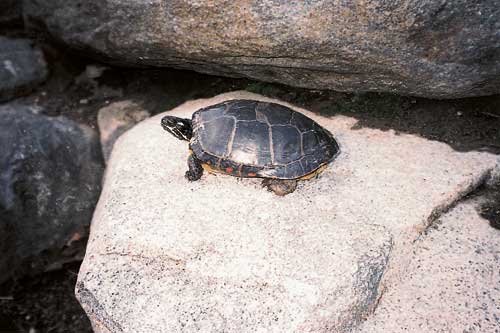Paul Basham sent us this article on painted turtles. For you animal-lovers (or reptile-lovers) out there, here's everything you ever wanted to know!
The painted turtle is the most widely distributed fresh water turtle in the United States and is the only one to range from coast to coast. Its habit of basking in the sun on floating logs or on rocks along the shoreline and silently slipping back into the water when disturbed is well known to persons boating or canoeing down a lazy river.
The painted turtle is so named because of the streaks of yellow and red on its black skin and especially for the bold elaborate colors of yellow, orange and red on the bottom edge of its top shell. It is as if someone used a paintbrush to identify an inpidual turtle. Clifford Pope, in his book, “The Reptile World,” calls the painted turtle “the most beautiful turtle in the northern half of the United States.”
One of the amazing features of the painted turtle is its innate ability to migrate. The female turtle will come out of the water to search far and wide on land for the right spot to dig a hole in the earth with good exposure to the sun and lay her eggs. She is seemingly oblivious to the fact that the young hatchlings must find their own way back to the water without parental guidance.
With so many predators looking for a tender snack, the young turtle has no time to waste. Nothing in its experience has prepared it for the perilous journey. It can not turn back to its womb in the earth but must be true to its “internal compass” and keep moving. The long migration to the water may take more than a day and encounter all kinds of dangers and barriers. It is the riskiest mission of its young and potentially long life.
Another remarkable feature about the painted turtle is its ability to hibernate in the mud at the bottom of frozen lakes and ponds during the long winters. The painted turtle is noted for being able to survive up to five months of hibernation, longer than any other air breathing vertebrate. Like many other hibernating turtles and amphibians, painted turtles are able to absorb oxygen from the water during hibernation by way of blood vessels in their skin.
Yet another trait of painted turtles, especially in their northern range, which includes New Hampshire, is the fact that after the turtles break out of their shells they can remain underground all winter and emerge out of their nests the following spring.
In his book “The Year of the Turtle,” New Hampshire naturalist David Carroll writes, “A six-year monitoring of painted turtle nests in Ontario, Canada, revealed no instances of hatchling emergence in the fall.” He adds, “These hatching painted turtles have been found to be freeze tolerant, which enables them to survive repeated exposures to temperatures as low as 18 degrees F.”
A heavy snow fall is a great help in insulating the newly hatched painted turtles that spend their first winter in their nests. By waiting until the spring to dig their way out of mother earth, the young turtles have a better chance of surviving and scampering back to mother water.
This summer, if you navigate any of New Hampshire's scenic waterways and see some painted turtles basking in the sun on a floating log, remind yourself you are looking at some remarkable creatures.










July 6, 2019
What I need to know is: how do I find out the sex of my painted turtle?? What is the difference visually? What can I look for distinguish if it’s male or female??